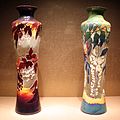Cristalleries du Val-Saint-Lambert
The Cristalleries du Val-Saint-Lambert are a glassworks in the former Val-St-Lambert monastery in Seraing , Belgium .
history
Vase from the period between 1909 and 1914, Hessisches Landesmuseum Darmstadt
The chemist François Kemlin (1784–1855) and the polytechnician Auguste Lelièvre (1796–1879), together with a group of financiers, founded the Cristalleries du Val-Saint-Lambert glass factory in a restored Cistercian abbey from the 13th century in Seraing, located on the Meuse south of Liège . The manufactory started operations in 1826. The large-scale production of all types of glass was facilitated by the proximity to the Meuse, the surrounding coal-rich region, a rail network and the large monastery complexes. At the end of the 19th century, the area around the former abbey grew into a village with more than 180 workers' apartments, small gardens, a school, a shop and a hospital. Around 5000 workers produced around 120,000 pieces of glass a day in the crystal works.
The First World War abruptly interrupted expansion as several key markets such as the Balkans and the Russian and German empires collapsed. The works were reopened in 1918, and by 1920 the glass works had already reached 90 percent of pre-war production. In 1926 Val-Saint-Lambert operated four factories with a total of 14 glass furnaces, each with 16 crucibles. 4,000 workers produced 140,000 pieces a day. The company provided 225 houses for accommodation for 840 workers from 228 households. 150 of these workers were between 14 and 18 years old. During the celebrations for the centenary of the glassworks in the same year, the later Belgian King Leopold III. Awards to approximately 1400 of the workers who had been with the company for at least 25 years.
The global economic crisis from 1929 and the bombing in World War II hit the crystal works hard. The decline continued into the 1960s and 1970s, when the introduction of the diamond cutting disc for easier cutting and engraving and the replacement of the traditional port furnace with a tank furnace , in which solid raw materials could be melted into liquid glass, improved the situation.
From the 1970s, the owners changed several times, each restructuring the company according to their ideas. Today the Val-Saint-Lambert crystal works are run by the Onclin family. The summer palace of the Prince-Bishops of Liège, which was formerly part of the abbey, is now the Musée Cristal Discovery , which houses 250 crystal glass works made in Val-Saint-Lambert.
Designer and exhibitions
At the end of the 19th century, and especially from 1900, numerous works made of lead crystal were carried out in Art Nouveau style; from around 1920 the style changed in the direction of Art Deco . Designers such as Léon Ledru (1855–1926, head designer from 1886 to 1926), Victor Horta , Henry van de Velde , Joseph Simon (1874–1960, head designer from 1926), Charles Graffart (1893–1967, joined 1906, head designer from 1929), as well as the brothers Désiré (1877–1952) and Henri Muller ( Frères Muller , both worked for the glass works in 1906) designed the pieces of glass that were handcrafted in the hut.
Works by Ledru, Simon and Graffart were shown at the Paris Exposition Internationale des Arts Décoratifs et industriels modern in 1925 . The Cristallerie had been preparing for this since 1919 and showed 60 exhibits. The international jury headed by René Lalique decided unanimously to award the glassware on display with the Grand Prix . Many of the pieces were also exhibited at the Foire Commerciale in Brussels that same year .
literature
- Victor Arwas : The Art of Glass: Art Nouveau to Art Deco. Papadakis Publisher, 1996, ISBN 1-90109-200-3 , pp. 106f.
- Giuseppe Cappa: Le génie verrier de l'Europe. Témoignages. De l'historicisme à la modernité (1840-1998). Editions Mardaga, 1998, ISBN 2-87009-680-1 , p. 51 ff.
- Alastair Duncan : Art nouveau and art deco lighting. Simon and Schuster, 1978, ISBN 0-67124-307-1 , pp. 53, 53, 141.
- Ray Grover, Lee Grover: Carved & Decorated European Art Glass. Tuttle Publishing, 2012, ISBN 1-46290-965-5 , pp. 19ff.
- Gérard LaCroix, Jean LaCroix: Val-Saint-Lambert Fantasy Crystal from the Art Deco Period (1919-1930). Gerard LaCroix, 2004, ISBN 0-97638-790-5 , pp. 1ff.
- Judith Miller : Miller's Field Guide: Glass. Hachette UK, 2015, ISBN 1-78472-071-2 , pp. 160ff.
- Joseph Philippe: Le Val-Saint-Lambert. Ses cristalleries et l'art du verre en Belgique. Halbart, 1974, ISBN 2-87011-032-4 , 349 pp.
Web links
- Val-Saint-Lambert. Yesterday. Website of the glassworks.
Individual evidence
- ↑ Auguste Lelièvre. Paris 4/08/1796, Seraing 15/02/1879. In: connaitrelawallonie.wallonie.be
- ↑ Harry L. Rinker: Warman's Antiques and Their Prices. Gage Learning Corporation, 1991, ISBN 0-87069-592-4 , p. 663.
- ^ A b Victor Arwas : The Art of Glass: Art Nouveau to Art Deco. Papadakis Publisher, 1996, ISBN 1-90109-200-3 , pp. 106f.
- ↑ a b c d Val-Saint-Lambert. Yesterday. Website of the glassworks.
- ^ A b c Gérard LaCroix, Jean LaCroix: Val-Saint-Lambert Fantasy Crystal from the Art Deco Period (1919-1930). Gerard LaCroix, 2004, ISBN 0-97638-790-5 , pp. 1ff.
- ^ Musée Cristal Discovery. In: cristaldiscovery.be
- ^ A b Ray Grover, Lee Grover: Carved & Decorated European Art Glass. Tuttle Publishing, 2012, ISBN 1-46290-965-5 , pp. 19ff.
- ^ Judith Miller : Miller's Field Guide: Glass. Hachette UK, 2015, ISBN 1-78472-071-2 , pp. 160ff.





